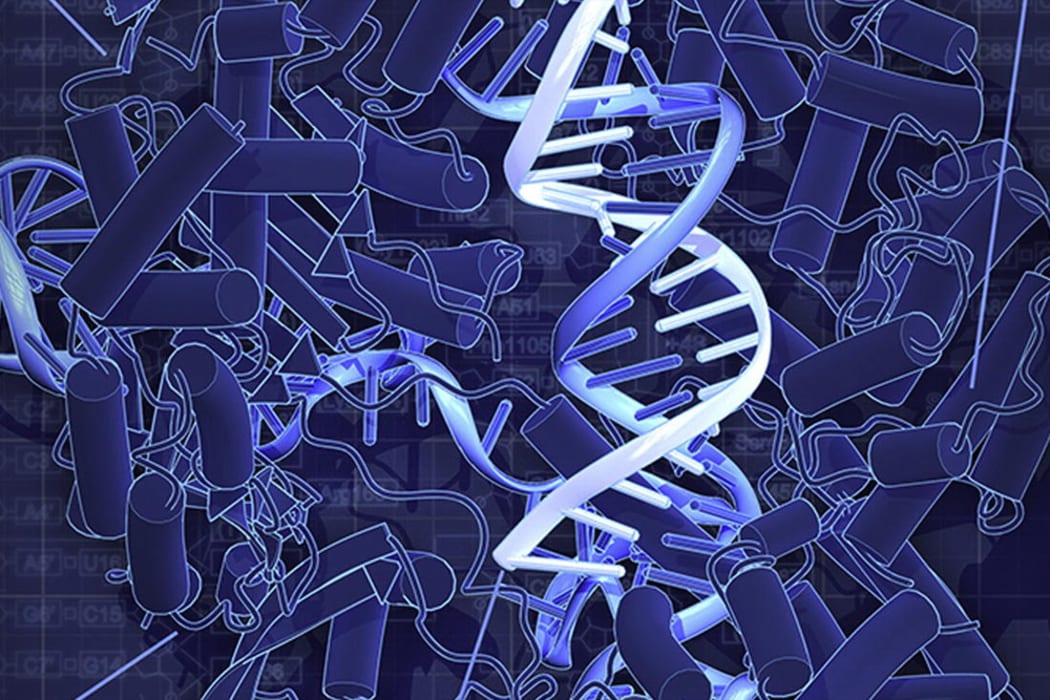CRISPR is the new buzzword in genetics, and University of Otago geneticists hope it will re-ignite a discussion about gene editing in New Zealand.

CRISPR is a new tool in genetics, allowing scientists to change, delete and replace genes with an unprecedented level of precision and reliability. Photo: Supplied
Peter Dearden and Neil Gemmell are both taking part in a series of public events to debate the latest technologies in genomics and gene editing and their potential benefits and risks.
The acronym CRISPR stands for “clustered regularly interspaced short palindromic repeats”, but that’s just a big mouthful for a new and hotly debated precision tool to edit DNA.
It allows scientists to change, delete and replace genes with an unprecedented level of accuracy. Already, teams elsewhere have used CRISPR in mice to correct the genetic errors responsible for sickle-cell anaemia, muscular dystrophy, and the fundamental defect associated with cystic fibrosis.
Scientists detected the system only a few years ago in bacteria, where it acts as a sophisticated kind of immune response.
“It’s designed so that bacteria can stop foreign bits of DNA,” says Peter Dearden.
“It recognises that bit of DNA and copies it into its genome into a particular place. That piece can then be used to make RNA, the single-stranded version, which can guide another protein known as CAS9 to the same sequence … and cut it.”

The CRISPR sequences are a crucial component of the immune systems of bacteria. Photo: Supplied
For a geneticist, the CRISPR-CAS9 system becomes a precise cutting tool, which has the potential to modify specific DNA sites in any organism, from simple slime moulds to us.
“Already people are starting to talk about the idea of editing gene sequences in particular ways to achieve desirable outcome, for example in humans,” says Neil Gemmell.
“This could be a gene editing tool to eliminate specific point mutations that are associated with lethal diseases.”
Other areas where CRIPSR is likely to have a big impact are agriculture and health.
“We could be looking at manipulations to modify traits in agriculturally important species so they produce more offspring or they produce more of the substances we want. And then there are other opportunities to manipulate things so that organisms would be resistant to particular diseases.”
He says one such target is the malaria-carrying mosquito which could be manipulated so that it no longer has the ability to carry the parasite.
Combined with another genetic tool known as gene drives, CRISPR could push a particular sequence into an entire population within a generation or two.
“That’s phenomenal in terms of its ability to manipulate the genetics of populations in relatively short times. And it would be fair to say that this has been explored extensively as an idea for controlling vector-borne diseases.”

A human embryo, here seen in its eight-cell stage, doubles its number of cells at each division. Photo: Wikimedia commons
Late last year, the UK authority that regulates genetic research approved the use of CRISPR in human embryos, for the first seven days and for research purposes only.
Even further than that, Neil Gemmell says it is now possible to think about “how we might help accelerate the evolutionary process by editing genes associated with heat tolerance or salinity tolerance in species of agricultural importance, or even of conservation or wildlife importance”.
But it is exactly this potential to change genetic research profoundly that also rings a note of caution. “CRISPR is simple and easy to use but has the potential to cause the extinction of entire populations or even species, so it’s something that should be used judicially,” says Peter Dearden.
He says the implications for genetically modified foods are also significant as it is essentially impossible to tell whether the technique has been used.
“When we talk about genetically modified foods possibly coming into the country, we use genetic tests to determine if there is a trans-gene in there, if there’s a piece of DNA which has been inserted into that genome. Modern CRIPSR techniques mean that we don’t have to insert a gene. “
“Now we have the opportunity of actually picking out a few base pairs in the genome and changing one or two of them. And those changes are effectively undetectable now because we leave no fingerprint in the genome.”
From a legislative perspective, it is possible to use CRISPR in the laboratory in New Zealand but any organisms manipulated with the technique are considered GMOs. Any proposal to release such an organism would have to go through the same process that covers genetic modification.
But nearly two decades after the Royal Commission on Genetic Modification, Peter Dearden says it may be time for New Zealand to have another discussion about gene editing.
“Now with CRIPSR there is such a range of possibilities that we need to work out where we are prepared to draw the line and how we’re prepared to hold that line, which is another problem as we can’t detect these modifications and can’t stop people doing it in their backyard.”
- Peter Dearden and Neil Gemmell and many other geneticists are part of the Gene Genie panel discussions that kick off in Christchurch on 15 March, all hosted by BBC presenter Adam Rutherford, who also features in Writers Week in Wellington.

